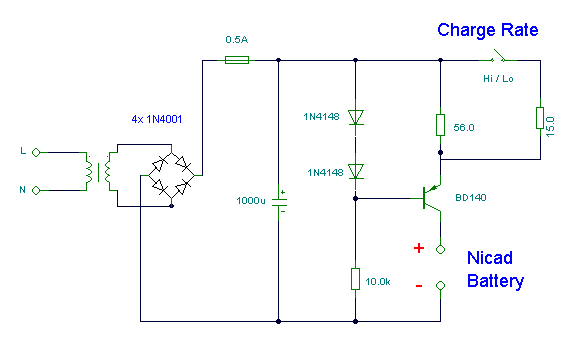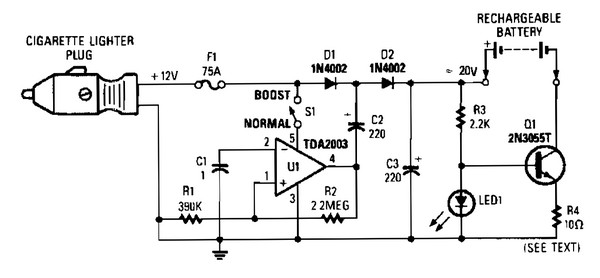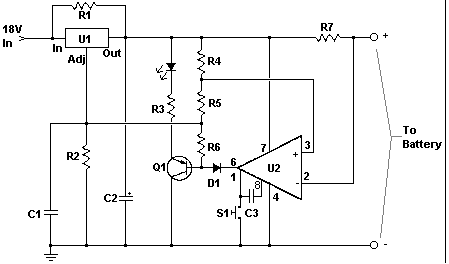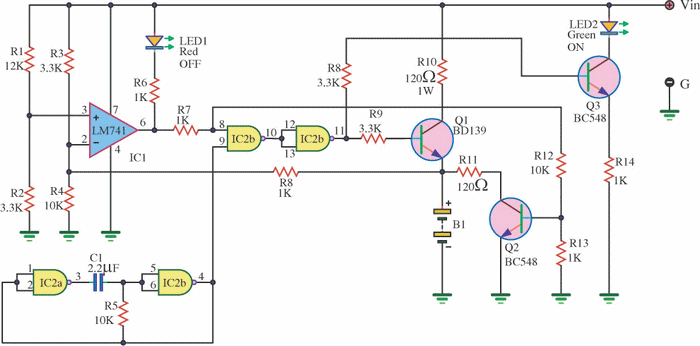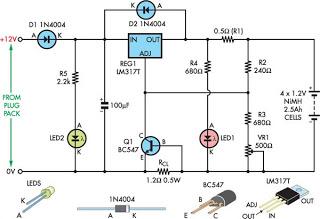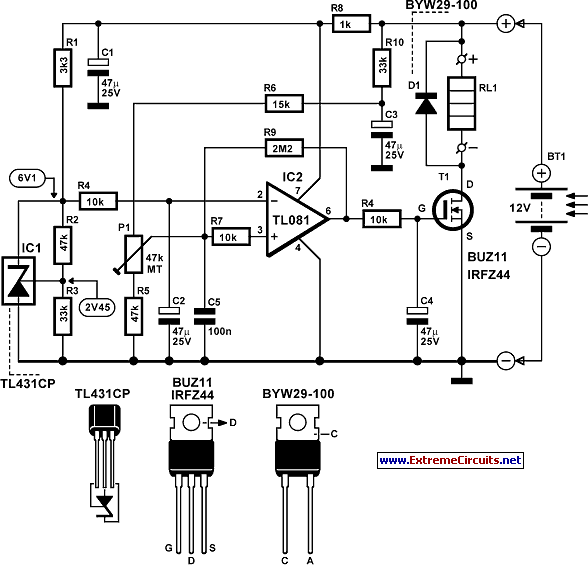
NiCd Battery Charger
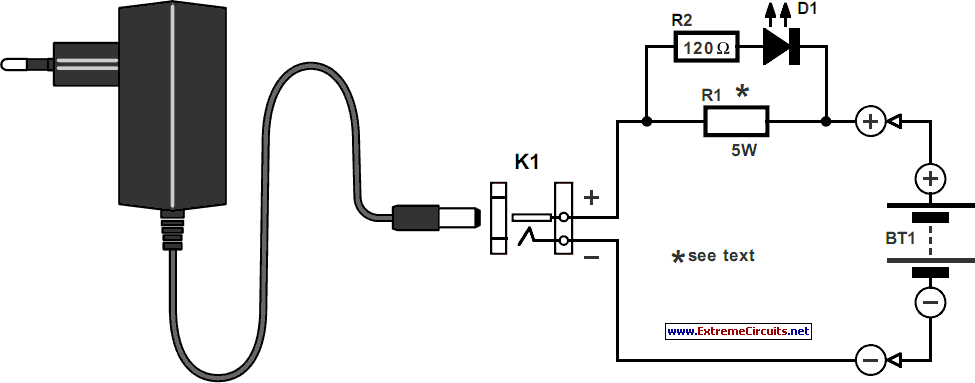
The charger design resembles that of many commercially available chargers. It comprises a mains adapter, two resistors, and a light-emitting diode (LED). This type of charger is effective in practical applications. Resistor R1 has dual functions: it establishes the appropriate charging current and reduces the voltage sufficiently to illuminate the LED. Consequently, the LED lights up only when a charging current flows into the battery. The charging current is approximately one-quarter of the battery capacity, allowing for slight overcharging while keeping the charging cycle within a reasonable duration of 4 to 5 hours. The resistor values can be calculated using the nominal electromotive force (e.m.f.) and the battery capacity. The mains adapter output should be set to 1.17 times the nominal battery voltage plus 3.3 V, which is the voltage across R1. It is essential that the adapter can supply at least half of the battery capacity in current. The resistance value of R1 in ohms is calculated as 3.3 divided by one-quarter of the battery capacity. A table provides the resistor values for various battery voltages, taking a battery capacity of 1 Ah. R1 should have a power rating of 5 W. If the battery capacity differs, the theoretical value of R1 from the table must be adjusted by dividing it by the battery capacity, with the actual value being the nearest standard resistor from the E12 series. For example, for a 6 V battery with a nominal capacity of 600 mAh, R1 should be set to 20/0.6 = 33Ω.
The charger circuit is designed to efficiently manage the charging process for batteries, ensuring that the LED indicator provides a visual cue for the charging status. The main components include a mains adapter, which converts AC voltage from the power outlet to a suitable DC voltage for charging. The circuit employs two resistors, where R1 is critical for determining the charging current and voltage drop necessary for LED operation, while the second resistor can be used for additional current limiting or voltage division depending on the specific application.
The charging current is carefully set to one-quarter of the battery's capacity to prevent overheating and excessive wear on the battery, while still allowing for a slight overcharge that can enhance battery life. The charging duration is optimized to between 4 to 5 hours, making this circuit suitable for various rechargeable battery applications.
The calculation method for R1 ensures that the charger adapts to different battery specifications by requiring knowledge of both the nominal voltage and capacity of the battery being charged. The output voltage setting of the mains adapter is crucial, as it must accommodate the voltage drop across R1 while providing enough potential to charge the battery effectively. The requirement that the adapter supply at least half of the battery capacity ensures that the charger can operate efficiently without risking damage to the adapter or the battery.
In practical scenarios, resistor values can be selected from the E12 series to ensure compatibility and availability. The design's flexibility in accommodating different battery capacities and voltages makes it suitable for a range of applications, from consumer electronics to specialized equipment requiring reliable charging solutions. Overall, this charger design exemplifies a straightforward yet effective approach to battery management, balancing safety, efficiency, and usability.The design of the charger is similar to that of many commercially available chargers. The charger consists of a mains adaptor, two resistors and a light-emitting diode (LED). In practical use, this kind of charger is perfectly all right. Resistor R1 serves two functions: it establishes the correct charging current and it drops sufficient voltage t o light the diode. This means that the LED lights only when a charging current flows into the battery. The charging current is about 1/4 of the battery capacity, which allows a slight overcharging, and yet the charging cycle is not too long (4 5 hours). The value of the resistors may be calculated as follows, for which the nominal e. m. f. and the capacity of the battery must be known. Adjust the output of the mains adaptor to 1. 17 times the nominal battery voltage plus 3. 3 V, which is the potential across R1. Note that the adaptor must be capable of supplying a current of not less than half the battery capacity.
The value of R1 in ohms is equal to 3. 3 divided by 1/4 of the battery capacity. The value of the resistors for various battery voltages is given in the Table. The battery capacity is taken as 1 Ah. The rating of R1 should be 5 W. If the battery to be charged has a different capacity, the theoretical value of R1 in the table must be divided by the battery capacity. Its actual value is the nearest one in the E12 series. For instance, if a 6 V battery with a nominal capacity of 600 mAh is to be charged, the value of R1 must be 20/0.
6 = 33R. 🔗 External reference
The charger circuit is designed to efficiently manage the charging process for batteries, ensuring that the LED indicator provides a visual cue for the charging status. The main components include a mains adapter, which converts AC voltage from the power outlet to a suitable DC voltage for charging. The circuit employs two resistors, where R1 is critical for determining the charging current and voltage drop necessary for LED operation, while the second resistor can be used for additional current limiting or voltage division depending on the specific application.
The charging current is carefully set to one-quarter of the battery's capacity to prevent overheating and excessive wear on the battery, while still allowing for a slight overcharge that can enhance battery life. The charging duration is optimized to between 4 to 5 hours, making this circuit suitable for various rechargeable battery applications.
The calculation method for R1 ensures that the charger adapts to different battery specifications by requiring knowledge of both the nominal voltage and capacity of the battery being charged. The output voltage setting of the mains adapter is crucial, as it must accommodate the voltage drop across R1 while providing enough potential to charge the battery effectively. The requirement that the adapter supply at least half of the battery capacity ensures that the charger can operate efficiently without risking damage to the adapter or the battery.
In practical scenarios, resistor values can be selected from the E12 series to ensure compatibility and availability. The design's flexibility in accommodating different battery capacities and voltages makes it suitable for a range of applications, from consumer electronics to specialized equipment requiring reliable charging solutions. Overall, this charger design exemplifies a straightforward yet effective approach to battery management, balancing safety, efficiency, and usability.The design of the charger is similar to that of many commercially available chargers. The charger consists of a mains adaptor, two resistors and a light-emitting diode (LED). In practical use, this kind of charger is perfectly all right. Resistor R1 serves two functions: it establishes the correct charging current and it drops sufficient voltage t o light the diode. This means that the LED lights only when a charging current flows into the battery. The charging current is about 1/4 of the battery capacity, which allows a slight overcharging, and yet the charging cycle is not too long (4 5 hours). The value of the resistors may be calculated as follows, for which the nominal e. m. f. and the capacity of the battery must be known. Adjust the output of the mains adaptor to 1. 17 times the nominal battery voltage plus 3. 3 V, which is the potential across R1. Note that the adaptor must be capable of supplying a current of not less than half the battery capacity.
The value of R1 in ohms is equal to 3. 3 divided by 1/4 of the battery capacity. The value of the resistors for various battery voltages is given in the Table. The battery capacity is taken as 1 Ah. The rating of R1 should be 5 W. If the battery to be charged has a different capacity, the theoretical value of R1 in the table must be divided by the battery capacity. Its actual value is the nearest one in the E12 series. For instance, if a 6 V battery with a nominal capacity of 600 mAh is to be charged, the value of R1 must be 20/0.
6 = 33R. 🔗 External reference
